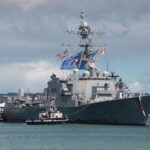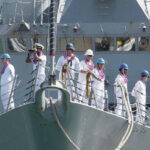USS Daniel Inouye returns from first deployment



The Navy destroyer USS Daniel Inouye returned Friday to its home port of Pearl Harbor as it concluded its first overseas deployment. On the edge of the pier, friends and family of the ship’s crew waited with signs and lei to welcome their sailors back home.
Named for the late Hawaii senator and World War II Medal of Honor recipient, the ship officially arrived in Hawaii in 2021 for its official commissioning ceremony. It set sail for its maiden voyage in January for what was supposed to be a seven-month deployment to the western Pacific as part of the USS Theodore Roosevelt Carrier Strike Group.
ADVERTISING
But the deployment was extended as the carrier group was sent to the Middle East as bloody regional conflicts widen and risk igniting into a full-blown regional war.
The people on the pier cheered as the ship came into view. Crews from nearby ships in the harbor also gave out shouts and cheers as the Inouye pulled in. As the sailors disembarked, they reunited with their loved ones. Several held newborn children — born during their deployment — for the first time.
“(After) nine months, the weight on our families has been tremendous,” said the Inouye’s commanding officer, Cmdr. Kevin Dore. “Every extension you feel that here, but then you know you feel that at home. So to be able to finally connect to those families and to give the crew some well-earned time to just rest and to rekindle the relationships, that is priceless. So we’re thrilled to be back.”
The mission took the ship and its crew across two oceans as they made port calls along the way and trained with ships from allied nations. They also navigated disputed waters and complicated politics, including rescuing stranded Iranian mariners at a time when global hostilities seem to be reaching a dangerous tipping point.
Dore told the Honolulu Star-Advertiser “in terms of being on time, on mission all the time, without exception, this crew responded like I have never seen before, and I’m absolutely so proud of their efforts to be ready at a moment’s notice all the time.”
“When one person was up or one person was down and needed some help, the team just rallied around and picked everyone up,” said the ship’s executive officer, Cmdr. Ryan Kelly. ”And every single thing that the crew was asked for, they delivered on.”
The Roosevelt Carrier Strike Group sailed west into the Pacific as it began its deployment, and in February trained with the USS Carl Vinson Carrier Strike Group in the Philippine Sea, along with a Japanese destroyer, in a show of strength in the Pacific where tensions have simmered with China.
Throughout the year, the Chinese military has ramped up operations around Taiwan and clashes have broken out near the Philippines over a series of disputed reefs and atolls that both China and the Philippines claim. Tensions ramped up this summer in a violent clash between the Chinese Coast Guard and Philippine navy that resulted in a Philippine sailor losing a finger.
Beijing claims nearly the entirety of the South China Sea, a busy waterway that more than a third of all international trade moves through, as its exclusive sovereign territory over the objections of many neighboring Asian nations. Chinese leaders have condemned U.S. military maneuvers in the region, accusing the U.S. of stoking tensions.
Diplomats from the U.S. and China, along with other regional countries, worked to quell tensions. Meanwhile, the Inouye and its crew trained with several regional navies and made port calls across the region, including stops in South Korea and Singapore.
“The mission really was encouraging stability with our partners,” Dore said. “(We continue to work on) interoperability with those nations, which is just strengthening ties as we continue to defend free commerce and open sea lanes, across an open and free Indo-Pacific.”
But worsening conflict in the Middle East saw the carrier strike group called to support a U.S. response there. On Oct. 7, 2023, Hamas militants launched a surprise attack on Israel that killed 1,200 people, mostly civilians, and took hostages back into Gaza. Israel responded by launching a full-scale invasion of Gaza that has killed thousands and displaced millions.
Iranian-backed Houthi militants in Yemen began a campaign of attacks on civilian merchant vessels. Though the Houthis say the attacks are in solidarity with Gaza, many of the ships they have attacked have no known ties to Israel. Iranian naval forces also have at times harassed and boarded vessels in the Indian Ocean.
The attacks have disrupted global shipping routes and the entire maritime industry, with rising insurance rates for vessels and many taking longer routes to avoid the region altogether to avoid attacks. Dore said “those are some exceptionally busy waterways that we’re making sure that commerce is able to move freely.”
The situation in the Middle East continues to deteriorate. On Sept. 27, Israeli forces killed Hassan Nasrallah, the leader of Lebanese militant group Hezbollah — a powerful paramilitary group with close ties to Iran. Israel has since sent ground troops into Southern Lebanon while also bombing the capital of Beirut in a campaign that has killed hundreds and displaced nearly a quarter of the country.
Iran responded with a massive ballistic missile attack against Israel, and Israeli officials have vowed to retaliate.
Diplomats are working furiously to walk the region back from the brink of all-out war. But while the Inouye was in the region, its crew managed to briefly transcend the geopolitical storm when it responded to a call to rescue Iranian civilian mariners who were lost at sea.
“A distressed mariner is a distressed mariner,” Dore said. “If an emergency like that happens, it is get there as fast as you can and do everything you can to save, in this case, two distressed mariners who happened to be Iranian.”
The rescue involved a small boat dispatched from the ship, two rescue divers and a helicopter crew that managed to find them, get them out of the water and onto the ship for food, water and medical care. Dore said they “really wanted to make sure they were safe, because they had been in the water for a significant period of time, so we were concerned about that.”
Kelly said of the rescue, “(Our crew trains) because you never know what you’re going to run into. And this crew, when that call was made, everyone just responded with their training. Everyone was cool under pressure, and they executed the mission just like we ask every single time.”
“That was really one of those moments where we were able to see the team fully come together. There were lives at stake, and the crew gets that,” Dore said. “It’s incredible to watch that happen, and really to be able to take action and to make a difference.”
For Petty Officer 1st Class Keith Kodani, a sonar technician on the the Inouye who originally hails from Aina Haina and attended Kalani High School, this was his sixth time deploying. It was also his longest.
“It was different, it was kind of tiring, but everything that we did, it was well worth it,” he said. “I was excited to train all the younger guys and newer guys on what’s going on, helping them through the experience, and especially on this namesake.”
For Petty Officer 3rd Class Jessica Sargent, a James Campbell High School grad, it was her first deployment. She said it “was challenging, but I had a great time. Got to meet new people and experience different cultures, different places. It was really fun.”
But now that the deployment is over, Kodani said he has one last mission.
“I’m going to Zippy’s,” he said. “I’m getting a chili chicken mix.”







